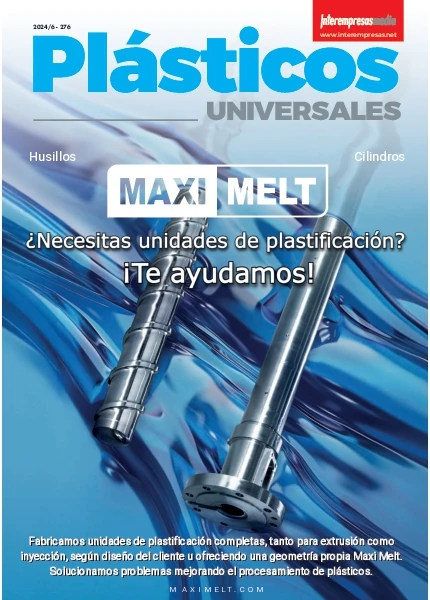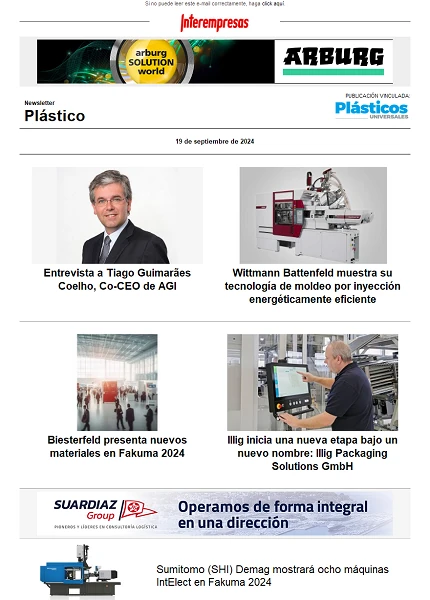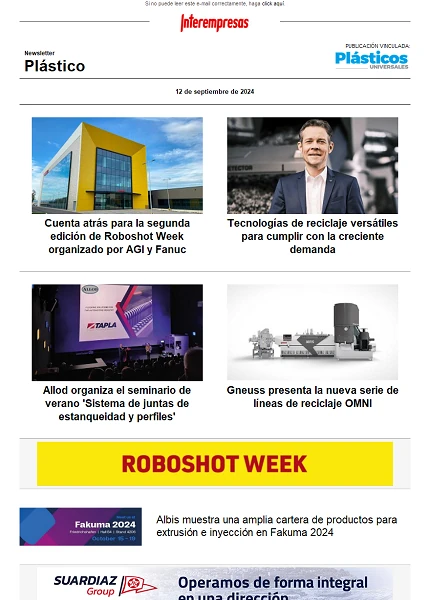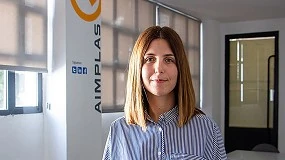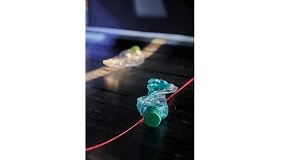Legislative environment of childcare articles intended for feed
Within the articles for infant feeding, there are two families of products, destined for liquid food as they are bottles, teats, nozzles, children's cups, vessels learning, among others, and which fall within the so-called "essential items" in regards of infant feeding. On the other hand, articles such as cutlery, dishes and bowls are the Group of the cutlery and utensils for the food, intended for the use of children from the average age of weaning (6 months) up to 3 years, so eat alone or with the help of another person.
As consumer products, childcare for infant feeding products are under the protection of the Directive 2001/95/EC concerning the General product safety (DGSP) European, so that the safety of the product is assured by compliance with standardsin the case of these articles are highly developed and include both physical and chemical aspects. This comprehensive development does, sometimes forget the specific legislation relevant to the use of these products, i.e. to contain food. The article summarizes both legislative and policy, requirements of childcare products intended for infant feeding.
European Directive 2001/95/EC on general security of products (DGSP)
Childcare articles should in general, as consumer products, comply with European Directive 2001/95/EC concerning the General product safety (directive incorporated the Spanish legal system by means of Royal Decree 1801 / 2003 of 26 December)(, on general security of products). The objective of this directive is to ensure that products placed on the market are safe. Applies to all products intended for consumers, which under reasonably foreseeable conditions, it can be used by consumers even if it is not intended, that is supplied or put at its disposal, to whether for consideration or, in the course of a commercial activitywhether new, used or reconditioned.
The DGSP refers to the European standards as a tool to evaluate the safety of the products. Shall be considered that an article is safe, in aspects covered by the European standard of applicable security, when cuando sea is accordance with the relevant standard. Standards are of particular importance as they facilitate the evaluation of the safety of the products both to consumers and producers and the competent authorities.
European safety regulations
Similar to other childcare products, each product has a specific rule. Articles for liquid food (bottles, teats, vessels learning...) must meet the European standard EN 14350, while rule for children's tableware and cutlery is the EN 14372.
The above-mentioned provisions lay down safety requirements concerning the materials, construction, mechanical resistance, packaging and labelling of these products, eliminate risks to the health of children arising from their use.
Main dangers. The European safety standards EN 14350 and EN 14372 cover certain mechanical, chemical hazards and related product information. Here are some of the dangers referred to in these regulations.
Mechanical hazards
Asphyxia. Suffocation is the main danger associated with the use of these articles, the separation of one of its components. For example, if the teat is out of the bottle during the siege, or if the nozzle is broken or rips. The rules take account of this danger and include specific safety testing.
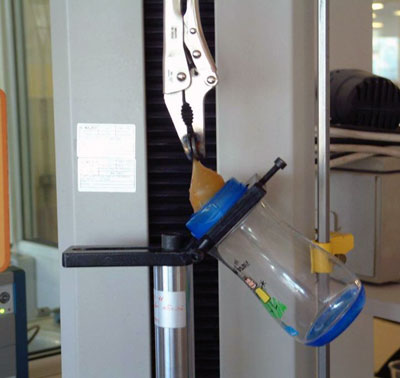
Also to avoid danger of suffocation, any component that is part of a covered or utensil for feed, must have a large enough such that is not likely to be swallowed by the child. This is verified with the help of the cylinder for small parts, probe test that simulates the throat of the child.
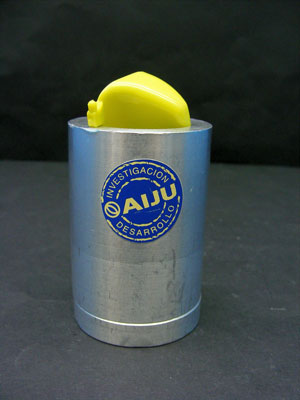
Dehydration. To avoid dangers of dehydration, it is very important that volumetric bottle brands are well graded so that the father or the mother can properly prepare the taking of his son. For example, for less than 100 ml brands tolerance is ± 5 ml. The laboratory checks that the indicated brand is within the tolerances specified by the European safety standard.
With regard to the volumetric marking of a bottle, as well as the volumetric accuracy of numbered graduations, note that:
- all bottles must be marked at least once with the letters 'ml'
- the smaller numbered graduation may not exceed 60 ml.
- the highest numbered graduation must be equal to the volume of nominal use of the bottle (volume indicated on the labelling of the product)
- the interval between numbered graduations should not exceed 60 ml.
Chemical hazards
Toxicity. EN 14350 and EN 14372 standards also deal with the potential dangers arising from the release of one or more substances in quantities which could be considered harmful to the health, of the materials used in the manufacture of products for infant feeding. Each with rules includes the methods of analysis for the chemical requirements specified.
The chemical to be in accordance with European standard tests depend on the nature of the materials that make up the product.
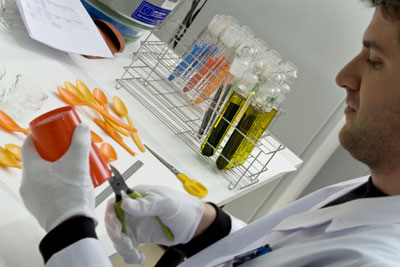
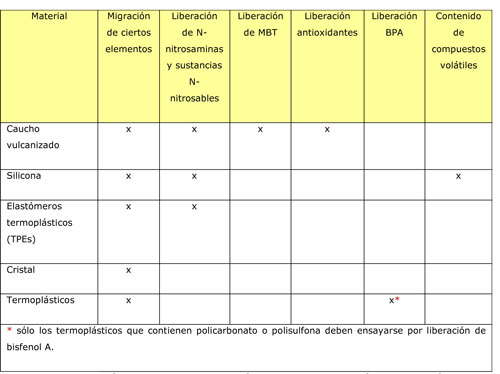
Migration of certain elements: As, Sb, Ba, Cd, Cr, Pb, Hg, and is. These elements are cumulative poisonous substances that may cause risks to health even in exhibitions to relatively small amounts, mainly through oral. There are a few more restrictive for childcare articles limits laid down to be sucked (light childcare articles: pacifiers, chains, teats, bottles, cutlery and crockery, etc), and some general limits more permissive for all other childcare articles (considering the area of the child).
Release of N-nitrosamines and N-nitrosatable substances: some childcare articles or made of rubber or elastomer parts can release N-nitrosamines and N-nitrosatable substances which are carcinogenic.
Migration of MBT and antioxidants: these products are used during the process of vulcanization of rubber to increase the thermal oxidation resistance and to prevent the attack of ozone, and can produce toxic effects primarily orally, so it limits on their migration had been established in those products in which their foreseeable use makes likely this type of exposure, for example, pacifiers, baby bottle teats and other components of the utensils of food and drink of young children.
Migration of Bisphenol A (BPA): Polycarbonate is a thermoplastic material with great transparency, which is widely used in the manufacture of utensils of food and drink for babies and toddlers. Bisphenol A is an important component of the polycarbonate, their migration in the mentioned products and must be controlled. Has been recently banned the use of 2, 2-bis (4-hidroxifenil) propane (BPA) in the manufacture of bottles from polycarbonate baby (2011/8/EU Commission directive of 28 January 2011 amending Directive 2002/72/EC as regards the restriction of the use of Bisphenol A in plastic bottles to infants).
Content total volatile components: that can be inhaled by children using these products.
Dangers of product information
Although safety standards aims to minimize the risks of accidents and injuries, it is not possible to maintain an optimal level of security without the help of the consumer. The information provided with the article is essential to publicize the dangers associated with the use of the article and the measures to be taken to ensure the protection of the child.
In the case of articles for liquid food (feeding bottles and teats) it is very important to communicate to the consumer risk situations arising out of certain uses, examples of possible phrases are:
- Accidents have occurred have been left alone babies with articles from the child falls or if the product has been dismantled. Therefore always use this product under the supervision of an adult.
- The microwave heating can produce localized high temperatures. Therefore always check the temperature of the food before the seizure.
- Caries can appear in young children even when not edulcorados liquids are used. This can happen if he is allowed to the child use the bottle for long periods of time during the day and particularly during the night, when the flow of saliva is reduced. For this reason, remember the prolonged and continuous suction of fluid can cause tooth decay.
Legislative environment for food contact materials
Summary
In addition to the above-mentioned European security regulations, the plastic components of the articles for infant feeding are regulated by the Commission Directive 2002/72/EC concerning the plastic materials and articles intended to come into contact with foodstuffs.
Directive 2002/72/EC of the Commission, of 6 August 2002, concerning the plastic materials and articles intended to come into contact with foodstuffs is a specific measure within the scope of article 5 of Regulation (EC) No. 1935 / 2004 of the European Parliament and of the CouncilOctober 27, 2004, relating to materials and articles intended to come into contact with food.
Is well known to the general framework on materials in contact with food (Regulation No. 1935 / 2004) in its basic principle: "materials and articles must be manufactured according to good practice so there is no transfer of components to foodstuffs which may pose a danger to human health"", unacceptably alter the composition of the food or alter the organoleptic capabilities of the same."
Under this general framework, different specific directives on materials seek to establish provisions to ensure compliance with the basic principle. Among the few available, is the directive on plastic materials in contact with food (2002/72/EC), with a number of limitations with respect to the materials of child care that we discuss below.
To sum up the directive on plastic materials and articles in contact with food (2002/72/EC), it should be mentioned that, well the contact is made on a temporary basis, or rather is repeated, these materials must be manufactured from the permitted substances listed in annexes andalso has to verify both the levels of migration to the above terms of use.
In the case of childcare articles, the use is generally repeated, which means that the level of global migration has to be established on the basis of the found value and the tendency of this with the repetition of the migration on the same article. However, and in addition to these requirements, each article requires in particular the control of certain chemicals.
Finally, it should be noted, that specific migration testing is not accurate sometimes. The same directive provides that it shall not be compulsory where the value of overall migration implies that you do not exceed the limits of specific migration (which applied you).
Other legal provisions of the European Union
These items must comply in addition any other relevant EU legislation, such as restrictions in annex XVII of Regulation (EC) No. 1907 / 2006 of the European Parliament and of the Council of 18 December 2006 concerning the registration, evaluationauthorization and restriction of chemicals (REACH) that affect the product in question (content of cadmium, lead, phthalates, benzene, etc.) and substances

Phthalates are additive, classified as toxic substances, used in the manufacture of products of plastic material. In the case of toys and children's articles, these substances could release when children are introduced these objects in the mouth. The concentration of six types of phthalates in toys and childcare articles (DEHP, DBP, BBP, DINP, DIDP and DNOP), in order to protect the health of children to the maximum is currently limited.
None of the six phthalates may have a concentration higher than 0.1 per cent in mass of the plasticised material of the above-mentioned products to children. Three of them (DEHP, DBP and BBP) this limitation applies to all toys and childcare articles; in the other three (DINP, DIDP and DNOP) the limitation affects those that can be placed in the mouth by children.
As a result, may not be marketed toys and childcare articles containing these phthalates in concentrations higher than those specified.
Aiju. Technology Centre of reference in children's products
Aiju, is a technological centre dedicated to promoting innovation, technological research and the competitiveness of the companies in the sector of children's products and entertainment. Aiju is the only European institution specializing in all aspects of products for child use, from study of raw materials, product design and evaluation of security to pedagogical studies. Therefore, it has become the technological centre of reference in the field of children's products and entertainment.
The laboratory of the Centre is fully equipped for all testing of application in the field of children's products (toys, childcare articles and children's parks, among others). The laboratory of Aiju has a long experience in the analysis of childcare articles, both from the point of view químico-físico materials and safety requirements which must satisfy the product during its life, being accredited by ENAC for testing according to European norm.
The different certifications achieved by the laboratory of Aiju for the conduct of his essays, constitute the best guarantee for product certification.


